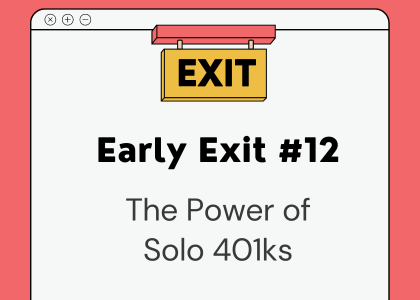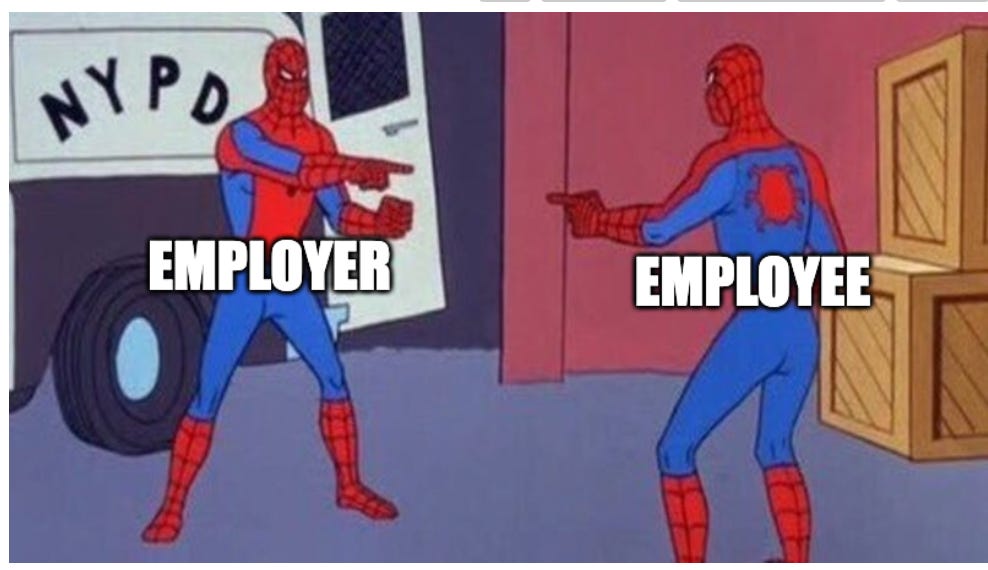Early Exit #12: The Power Of Solo 401ks
Save more for retirement and reduce your tax bill.
You’re reading Early Exit Club — a newsletter about leaving the 9-5 workforce to build a $20k/month solo business by Nick Lafferty.
Hey folks,
Welcome back to the Early Exit Club. Here’s what’s coming up in the next few weeks:
Next week we’ll talk about raising your rates and increasing scope with your clients
The week after is my big August financial update where I’ll tell you exactly how much money I made this month.
And today we’re going to talk about retirement accounts.
Wait, don’t leave yet. I’m a hyper nerd about this stuff and today you’re going to benefit from it.
Every self-employed person should be doing this (but no one I’ve talked to is).
Quick disclaimer: nothing here is financial advice. I’m just some guy on the internet, please do your own research before making any financial decisions.
We will all eventually stop working, and one of my goals is to hit that point earlier than average.
The average age of retirement here in the U.S. is 62 but I always thought that was too far away, so I looked for ways to move that date way, way up.
My goal was to retire by 40.
I wanted to hit a point where I could do whatever the hell I wanted to.
Maybe that means working for 1 or 2 clients that I’m really passionate about.
Or maybe that means spending a year doing nothing but making music, trying to become the next Skrillex like the CEO of Goldman Sachs.
Here’s how I’ve been using Solo 401k accounts to save silly amounts of money for retirement, and anyone with a little bit of side income can start doing this today.
This is most relevant to folks in the US and less relevant to my friends in Canada and overseas, but there might be an equivalent of this in your country. If there is I’d love to know in the comments below.
Introducing the Solo 401k
401ks are employer-sponsored retirement accounts that are sheltered from taxes where you can contribute a portion of your paycheck to invest in things like stocks, bonds, and mutual funds.
Some really good companies will match a portion of your 401k contributions, which is literally free money.
But did you know self-employed people also have access to 401k accounts?
And they can contribute both as the employer and the employee?
It’s called a Solo 401k(or individual 401k).
Here’s an example from my business.
My Example
First, let’s get some terminology out of the way.
If you own a business, you technically wear two hats:
An employer (you own the business)
An employee (you also work at that business)
This distinction is important because as an employer you can contribute a portion of your net profits to your employees retirement accounts.
Remember how I said really good companies can make matching contributions to their employees retirement accounts?
You can do that for yourself.
Imagine that your business made $30,000 in net income in Q1 of this year.
If your business, like mine, is incorporated as a sole proprietorship(or a single member LLC) then the IRS allows you to contribute up to 20% of your net income to your employees retirement accounts. If you’re an S Corp then the limit is 25%
So 20% of $30,000 is $6,000. Sweet!
But it gets better.
If you’re married and your spouse works for your business, you can make profit sharing contributions on their behalf too.
Therefore, your spouse can be a co-owner or simply an employee in your business. As long as your spouse is actively involved in the business as an employee (full-time or part-time is OK) or is an owner of the business, they can also be in your Solo 401k.
So not only can I make a profit sharing contribution of $6k to my 401k account, I can do the same for my wife because she helps with the business.
That’s a total of $12,000 or 40% of my net income.
This also reduces my tax burden because it’s an employee benefit, so now I only pay taxes on the difference ($18k).
You also don’t have to contribute the full 20%, you can do any amount you want up until 20%.
This is great if you’re strictly self-employed, but it’s even better if you’re still working full time and you have side income.
Double dipping 401k contributions
In 2023, there’s an annual limit of $66,000 for contributions to 401k plans. That limit is made up of the employee limit ($22,500) and the difference ($43,500) is what employers can contribute as profit sharing.
As a full time employee at my previous company, I was contributing the maximum employee limit to my 401k account of $22,500.
That employer wasn’t matching my 401k contributions, so their profit sharing contribution was $0.
But because my side business was earning income, I made profit sharing contributions from my business as the employer.
Every quarter I’d make the maximum allowable 20% contributions as an employer to my Solo 401k account, adding another $5-10k to my retirement accounts.
I could do this because I was living off my main income and using my side income to fund my early retirement goals.
Pretty cool, right?
Yeah but this is really complicated
I hear you. Not everyone gets excited about 401k contributions and retirement accounts.
But if you’re self employed you should still look into this because it lets you shove more money into investment accounts and it reduces your tax burden.
And like everything in the world right now, there’s a service that can help.
For an annual fee of $99 (plus a one-time setup fee), Solo401k.com (this is an affiliate link) will walk you through everything you need to setup your own Solo 401k account.
They’ll create and file all the documents you need and will give you a nifty portal to login, select your investments, and make your contributions.
You can input all your numbers and they’ll do the math on how much you can contribute.
It’s the best option for normal people that don’t write 2,000+ word newsletters about 401ks.
For the more adventurous, Vanguard, Fidelity, and Schwab all have Solo 401k (also called individual 401k) plans available and with a little bit of research you can set one of these up yourself.
Solopreneur of the Week: Alison Baldyga
Alison is a creative operations consultant and coach who is passionate about supporting small businesses and startups to do their best work.
She thrives in roles where she can foster connections and collaborate with others, create and iterate processes, build organizational structures, and research and analyze data to find patterns and trends.
Drop her a note on LinkedIn to say hi and reach out if you think she can help you.
Want to be featured? Add yourself to my Solopreneur Directory.
Wrapping Up
Whew, this was a doozy. This was my first time going deep on a complex financial topic.
How’d I do? Let me know if you have questions or feedback.
See you all next week!
Cheers,
Nick
Did someone send this to you? First, tell them thanks. Second, maybe you should subscribe too?






Okay I knew about Solo 401ks but currently only have a Roth IRA. This was such a simple and helpful explainer! Thanks for the deep dive, Nick!
Thanks Nick for the clear explanation and the nudge! Seems like a no brainer and one of those things where it definitely pays dividends to pay someone to handle it for you. Nice timing too, since there’s still time to get this set up for this tax year. 🙌